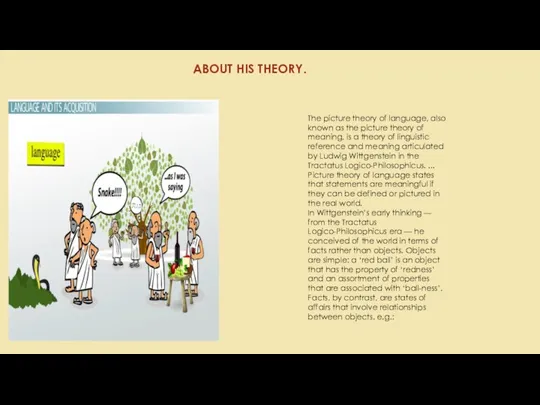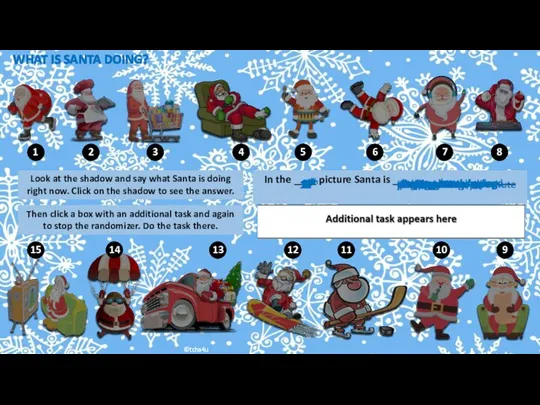- Главная
- Английский язык
- Ludwig Wittgenstein

Содержание
- 2. Dissatisfied with earlier attempts by Gottlob Frege and Bertrand Russell, Ludwig Wittgenstein (1889-1951) attempted to elucidate
- 3. ABOUT HIS THEORY. The picture theory of language, also known as the picture theory of meaning,
- 4. Two Content Layout with Table First bullet point here Second bullet point here Third bullet point
- 6. Скачать презентацию
Слайд 2Dissatisfied with earlier attempts by Gottlob Frege and Bertrand Russell, Ludwig Wittgenstein
Dissatisfied with earlier attempts by Gottlob Frege and Bertrand Russell, Ludwig Wittgenstein

(1889-1951) attempted to elucidate the nature of logical truth in his Tractatus Logico-Philosophicus (1922). Wittgenstein was concerned with the relation between language and the world and the logical and mathematical ramifications of this relation (Bunnin and Yu 739, Blackburn 390). In the Tractatus, Wittgenstein asserted that in order to describe reality, logic is necessary, but not sufficient and, in so doing, put forth what has come to be known as the picture theory of meaning (Rohmann 430). In his picture theory of meaning, Wittgenstein argued that language mirrors reality. However, Wittgenstein was not concerned with ontology, per se. He believed that the language used in this sort of metaphysical inquiry simply mirrored the logical structure of its subject matter, making the inquiry itself unnecessary by virtue of the impossibility of its very nature (Hunnings 2-3). Wittgenstein’s picture theory of meaning succeeded in explaining the possibility of falsehood, but ultimately broke down due to its reliance on the atomic propositions it posited, which proved to be untenable.
Слайд 3ABOUT HIS THEORY.
The picture theory of language, also known as the picture
ABOUT HIS THEORY.
The picture theory of language, also known as the picture

theory of meaning, is a theory of linguistic reference and meaning articulated by Ludwig Wittgenstein in the Tractatus Logico-Philosophicus. ... Picture theory of language states that statements are meaningful if they can be defined or pictured in the real world.
In Wittgenstein’s early thinking — from the Tractatus Logico-Philosophicus era — he conceived of the world in terms of facts rather than objects. Objects are simple: a ‘red ball’ is an object that has the property of ‘redness’ and an assortment of properties that are associated with ‘ball-ness’. Facts, by contrast, are states of affairs that involve relationships between objects. e.g.:
In Wittgenstein’s early thinking — from the Tractatus Logico-Philosophicus era — he conceived of the world in terms of facts rather than objects. Objects are simple: a ‘red ball’ is an object that has the property of ‘redness’ and an assortment of properties that are associated with ‘ball-ness’. Facts, by contrast, are states of affairs that involve relationships between objects. e.g.:
Слайд 4Two Content Layout with Table
First bullet point here
Second bullet point here
Third bullet
Two Content Layout with Table
First bullet point here
Second bullet point here
Third bullet

point here
 What is Santa doing
What is Santa doing Where are the easter eggs. Grammar
Where are the easter eggs. Grammar Snow in new York by Robert Henri
Snow in new York by Robert Henri Christmas
Christmas Question words spin easy
Question words spin easy Masters of English
Masters of English Shapes and colours
Shapes and colours How Are You Today?
How Are You Today? Сelebrations in New Zeland
Сelebrations in New Zeland Времена Simple
Времена Simple Презентация к уроку английского языка "ECOLOGY Our Fragile Planet" -
Презентация к уроку английского языка "ECOLOGY Our Fragile Planet" -  ThemeGallery is a Design Digital
ThemeGallery is a Design Digital Measure
Measure Complete the following with: a; an; the; or - nothing
Complete the following with: a; an; the; or - nothing Treasure hunt
Treasure hunt ИГРА «СКАЖИ…»
ИГРА «СКАЖИ…» Презентация на тему TO BE GOING TO
Презентация на тему TO BE GOING TO  Moscow is the largest and one of the most beautiful cities in Russia
Moscow is the largest and one of the most beautiful cities in Russia Tag-questions
Tag-questions Canada. General Facts
Canada. General Facts Verb
Verb Speaking: Healthy and Unhealthy habits
Speaking: Healthy and Unhealthy habits Роберт Бёрнс. Burns Night
Роберт Бёрнс. Burns Night His name is Pasha
His name is Pasha Pre-intermediate
Pre-intermediate Презентация на тему Грамматические времена
Презентация на тему Грамматические времена  Boys battle
Boys battle The legality in public administration
The legality in public administration